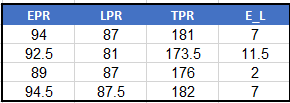Quote:
Originally Posted by navyvet1994

Bill V I see your sticks in this how do you come by what is good and what isn't. Do you base it on the numbers against the average or do you use a different formula?
|
Hello
Lots of practice.. and record keeping.
A good way to get started. Is to visualize what wins at the tracks you play.
What has helped me over the past 21 years is to record what winners earn
on the early late sticks and the EPR and LPR differences and parameters
Here is horse 6 from a race at Pax today
Let's focus on line 7 It is a win line from Parx at 6 furlongs .

Line 7 is a winning effort at Parx at 6 furlongs, six furlongs is the exact same distance as today's race.
What I record are the 3 phase 1 readouts EPR, LPR, and TPR from pacelines where a horse won at the exact same track, and distance
Today at Parx in all the 6-furlong races, these are the lines that were winning pacelines at 6 furlongs at PRX

This is a very small sample but if you do this for awhile you will soon have a good idea of what is too early or too late.
You may very well become much better using your mind's eye and
perform a very simple matchup
This small sample shows us. The pace of race EPR at Parx is to be over 90
and the LPR to be around 85-86
The E/L Parameters are usually between 7 and 11
This is a way too small sample to go by. What this record keeping
does show is what is a good line when picking lines
and when a horse probably is too early
Or if its a sustained horse, will it be close enough at the EPR to catch the
leaders
Using Phase 1 and VDC is a very simple answer to the complex game